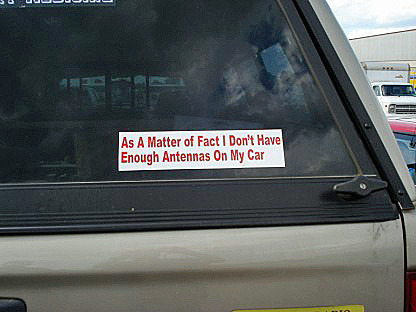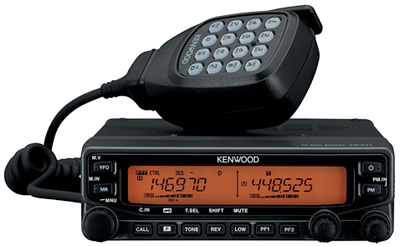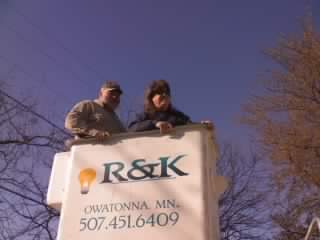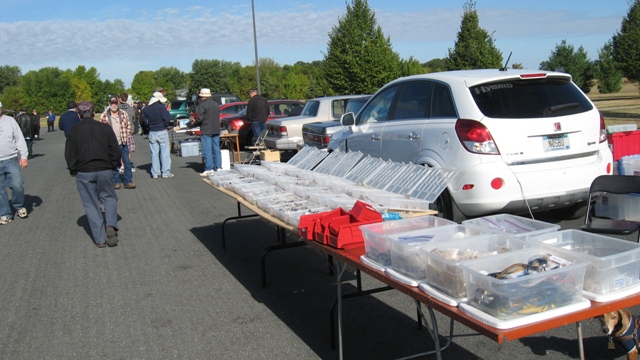Welcome to Handiham World.
George, N0SBU, writes: "PJ and I had a quiet weekend. We went to the Rush City swap meet. I looked around and PJ sold connectors or something like that."
The picture George sent me shows the Rush City swap meet parking lot, where the outdoor event participants enjoyed a perfect Minnesota Saturday. George sells connectors, so his tables are neatly organized with plastic bins of all sorts of electronic connectors and related accessories. The N0SBU license plate can be spotted on George's SUV in the background. Can you spot PJ, his helper? She is a sweet as can be little puppy and a good guard dog and sales associate for "Connectors by George". Blind users can find her by reading the alt-text in the photo field. Where is George, N0SBU? He is behind the camera, taking the picture!
George mentioned to me that he didn't see me at the swap meet. That is certainly true, because I went to my local radio club meeting that day. The Stillwater (MN) Amateur Radio Association (SARA), a Handiham affiliated club, kicked off its new ham radio meeting season with an excellent program on digital modes. The meeting was full of operating news - two special events that the club would be running, plus an on the air experimental digital net using PSK-125.
Sometimes it seems there is nothing going on and then the ham radio calendar gets so busy that one has a hard time picking and choosing between the events!
But September is the traditional month for radio clubs in North America to end their summer hiatus and get back to business, so I guess it is not surprising that there will be much more activity, both at the clubs and on the air from this point on. Check out the usual sources to get an idea of where the action might be, then plan to have fun on the air. The QST and CQ magazines both list events. The ARRL website has an excellent radio club locator resource that allows you to find a club near you. Several ham radio websites have news and information announcements, and club websites post club events and news.
This special edition of your Handiham World looks at a few troubleshooting issues with antennas and feedlines to help you get back in the running for some great on the air fun this ham radio season!
Email me at
handiham@couragecenter.org with your questions & comments.
Patrick Tice, WA0TDA
Handiham Manager
Troubleshooting 101: Keeping an open mind.

Okay, here's the scenario: I have not been on the HF bands in a while - been busy with summer stuff, you know - and now I am all jazzed up about getting on the air after hearing about contesting and DX at my first local ham club meeting of the season. I dust off the radio and turn it on, tuning to 20 meters and I hear... Nothing except a little hiss. This is a major bummer, because I was so excited to get on the air! Now I will have to go out and weed the garden as my wife suggested.
Ha, ha, of course I am not going to do that! I will troubleshoot the problem instead because that is better than digging out weeds with roots that go to China.
Consider that a problem like this one can have many causes. The radio is not receiving any signals but I know that it is turned on and there is some noise coming from the speaker. Keeping an open mind when approaching a troubleshooting project is not just a good idea - it may be essential to actually locating and resolving the issue!
Let me illustrate this concept by visiting two guys who have the exact same receiving problem. These guys are both imaginary and are not based on any real person, but if either one sounds like it might be you, well... What can I say? Learn from your experience.
Ham Guy 1: Buster finds his station as just described. He has seen this problem before, so he knows that he is in for a day of antenna work. He switches off the radio and heads out to the garage to collect the climbing gear and all the necessary tools, including the safety harness and a hard hat. With a neighbor performing the spotting duty of being watchful in case Buster should need help, up the tower he goes. The first step is to cut away the sealant and the tie wraps securing the balun near the top of the tower. This allows the balun to be disconnected from the feedline and the antenna. Buster then places the balun in the carry pouch he has on his safety belt and begins the climb back down the tower. Back on the ground, he can open up the balun to solder the broken wire that he knows caused a problem several years ago. The balun is tightly sealed, so he takes it down the basement to his well-lighted workbench to get the case off. Those screws are really tight! Finally the balun case yields and it is possible to get at the wiring. But wait! Everything looks just fine. An ohmmeter check shows that all of the balun's circuitry is intact! Nothing seems to be wrong, and there is certainly no hint of any damage from overloading or a lightning strike. Still, better safe than sorry, so Buster gets into the car and drives to his nearest ham radio store to purchase a new balun.
"There is no point in climbing that tower again with a bad balun", he thinks.
With the new balun in hand and the helpful neighbor once again recruited to act as a spotter during the tower climb, Buster heads on up. The new balun is easy to install, but the coax sealant is kind of a mess to work with, so he decides that it might be better to come back down the tower and run a test on the repaired system before sealing the connectors - just in case.
Ham Guy 2: Dexter finds his station as described above. He sits down to think about it for a minute.
"There could be one or more things wrong here", he thinks to himself. "Might as well check the easy stuff first."
After checking the rig's attenuator setting (off) and the RF gain control (100%), Dexter reached around the back of the rig and felt the disconnected PL-259 plug. That's when he recalled that a few weeks ago he had disconnected the antenna when thunderstorms had been forecast and because his summer had been quite busy he had not been on the radio since.
"I'm getting a bit forgetful", he thought to himself as he reconnected the antenna, after which he proceeded to get on the air and make a dozen DX contacts.
Meanwhile, back at Buster's house: Buster fired up the radio and the band was still dead. It was only then that he discovered the coax that he had also disconnected when the thunderstorms rolled through several weeks ago. He connected the feedline and the band came alive. The patient neighbor spotted for him again when he climbed the tower to seal the coax and replace all the tie wraps, completing the antenna project. By then it was much to late to get on the air.
Which ham radio troubleshooter are you? Do you open your mind up to all the possibilities? Or do you simply know what to do because you are sure you are right?
This is not a rhetorical question. It is a serious matter when working out real-world issues. Not only can a closed mindset send you down the garden path in a completely wrong direction, it can be part of a thinking pattern that can actually cause safety issues. Let's take a look at what caused Buster to waste an entire day replacing a perfectly good balun.
Mistake 1: Assuming that history predicts the future.
Buster had experienced antenna problems before. In fact, the memory of replacing a bad balun was still pretty fresh in his mind. The symptoms of the problem had been exactly the same. He made the mistake of assuming that history (the balun that had really gone bad a few years ago) had repeated itself this year. That was not the case. The problem with assuming that the future can be predicted by a past event is that the future has not yet happened! New things happen for the first time every day. None of these things could be predicted by a past event in history. Consider the case of a dead radio. One time it may be a tripped circuit breaker and nothing more. Another time the breaker may be tripped because of a shorted transistor that has caused the excess current draw. Another time the power supply may have gone bad. Maybe the power switch has failed. The radio may be unplugged from the power supply. Maybe the power is off to the entire neighborhood because a tree has fallen on the power lines. Don't assume that just because one of these events caused the problem last week it must be the same thing this week!
Mistake 2: Failing to consider alternatives.
Buster assumed that he knew what the problem was right from the outset. He did not take a few minutes to think about other possibilities. Nothing could change his mind at that point because he was so sure he knew the answer. He proceeded to waste time and resources chasing down the wrong "problem".
Mistake 3: Failing to understand probabilities.
As we have learned, one must consider alternatives when deciding what path to take with troubleshooting. Dexter considered several possible conditions that could cause the problem, but he wisely thought about probabilities and did not consider the less likely possibilities - at least at first. Although the problem was simply a disconnected feedline, it could have been a bad balun. But how often do baluns actually fail? The probability of that kind of failure is relatively low compared to leaving the RF gain control in the wrong position or forgetting to reconnect a feedline after a thunderstorm. To press the point, it is also possible that a passing meteor zinged right through your feedline and you never noticed a thing. Some things are so improbable that they are not worth considering until the easy and much more probable stuff has been exhausted. It is way more likely that some simple thing is amiss, so take a few minutes to think things through before wasting time on the least likely scenarios!
Mistake 4: Giving up.
To the credit of both Buster and Dexter, neither one gave up on the problem. They both eventually found a fix and their stations were both back in service. Had they given up, they would have abandoned a valuable tradition in amateur radio - working on one's own equipment. Even if a problem is too puzzling or requires extra hands on deck, it is always acceptable to ask for help. The amateur radio club in your area is a good place to start.
Sometimes it is fun - and always satisfying - to work our way through the troubleshooting process, learning as we go.
Distracted driving reminder
 Driving the car is your first responsibility!
Driving the car is your first responsibility!
Yesterday I spent the afternoon in one of those 55+ defensive driving refresher courses. You save money on your car insurance premium if you complete an initial 8 hour class, then you have 4 hour refreshers every three years or so. One of the hottest topics in driving safety these days is distracted driving. I remember my very first ham radio mentor telling me about how he just couldn't get on the two meter radio when he was driving because every time he did so he would end up concentrating on the radio and forgetting about watching his speed. Finally he got a speeding ticket and just quit using the radio in the car. That, of course, was long before the days of smart phones with their touch screen interfaces.
I've never had a huge problem using the VHF radio while driving, but that doesn't mean you can't still be distracted. The 2 meter rig can't even come close to the distraction potential of a modern smartphone! The phone has a touch screen that demands your close attention if you want to input information correctly. It does multiple things, often requiring its user to go through several screens while paying close attention to touching the exactly correct spot on the screen to move the process forward. Experts tell us that even hands-free smartphones cause considerable brainpower to be diverted from the primary task of driving the car.
How is it that ham radio operation is different?

Well, for one thing it is considerably easier to simply turn on a radio and use an existing repeater channel that is already stored in the transceiver's memory. The conversation is not full duplex, so you can talk or listen, but only one person has the repeater's transmitter at a time. Most everyone using the repeater understands that the conversation may be interrupted by a driving situation that demands the driver's full attention. Repeater conversations often go into a standby mode while traffic (car traffic) clears. All I have to do is let the person I am talking to know that I must concentrate on driving.
Emergency responders and police officers use the radio all the time. It is a skill that can be learned, but that still does not mean that the radio comes first. Your first job is ALWAYS to drive the car. To that end, you must be honest with yourself about how distracting you find the radio. If you only use it while the car is parked, you will be safe and can concentrate on your conversation. If you are on an empty freeway at noon on a sunny day, you may find the radio's use to be easy and safe. It all depends on you and the situation. What these periodic driving refresher course do is remind me that distracted driving can be a killer. Better be safe than sorry. Know your limitations and use the radio only when it will be safe to do so.
Don't forget about the new Tech Net!

We have heard lots of positive comments about our new Handiham Tech Net, a place to discuss technology related to amateur radio. The Tech Net is on the air at 19:00 hours USA Central Time each Thursday. The regular Handiham Radio Club Wednesday evening net is at the same 19:00 hour, just one day earlier. Daily nets are at 11:00 hours USA Central Time.
Frequency in the local Minnesota repeater coverage zone: 145.45 FM, negative offset with no tone and 444.65 MHz with 114.8 Hz tone in the Twin Cities of Minneapolis and St. Paul Minnesota. The UHF repeater will be heard more easily in the Eastern Twin Cities.
EchoLink nodes:
HANDIHAM conference server Node 494492 (Our preferred high-capacity node.)
KA0PQW-R, node 267582
KA0PQW-L, node 538131
N0BVE-R, node 89680
Other ways to connect:
IRLP node 9008 (Vancouver BC reflector)
WIRES system number 1427
A dip in the pool
 It's time to test our knowledge by taking a dip in the pool - the question pool, that is!
It's time to test our knowledge by taking a dip in the pool - the question pool, that is!
Let's go to a question from the Extra Class pool:
E5D07 asks, "What determines the strength of a magnetic field around a conductor?"
Possible answers are:
A. The resistance divided by the current
B. The ratio of the current to the resistance
C. The diameter of the conductor
D. The amount of current
This question is really sort of easy, isn't it? Of course you have to know beforehand that a magnetic field is created by the flow of current through a conductor. It stands to reason that the more current that flows, the higher the strength of the magnetic field that it creates. I am not going to stick my neck out and say that it is exactly proportional, because you can arrange the conductor in such a way as to concentrate the magnetic lines of force. I'm thinking of the case where you wind the conducting wire to form a coil, thus concentrating the magnetic field. The important thing to remember for your Extra Class exam is that a conductor carrying a current does create a magnetic field, and that a conductor moving through a magnetic field creates a current, because the two are physically related.
Please e-mail
handiham@couragecenter.org to comment.
Remote Base health report: W0EQO is on line. W0ZSW is on line.
Notice to users of W0ZSW: At this time we are recommending caution if you plan to transmit using W0ZSW. We have noticed an irregularity in the station's behavior where the station will receive normally for an indefinite period of time, but lock up and become unresponsive after the operator transmits two or three times. Your client software may show that you are still connected even when you try disconnecting. If this happens to you, please send an email to
wa0tda@arrl.net immediately so that the station can be disconnected. Then close the w4mq software on your computer and reopen it, and use w0eqo instead. W0ZSW is available for receive use via Echolink, a feature which is working well.
Solar activity is expected to be low with a chance for an isolated M-class flare for the first day (12 September). M-class probability is expected to decrease for the second and third days (13-14 September) as Region 1564 rotates out of view.
Geophysical Activity Forecast: Geomagnetic activity is expected to be quiet with a slight chance for unsettled levels on days 1 and 2 (12-13 September). An increase to quiet to unsettled levels with a slight chance for an active period is expected on the third day (14 September) due to a favorably positioned coronal hole.










